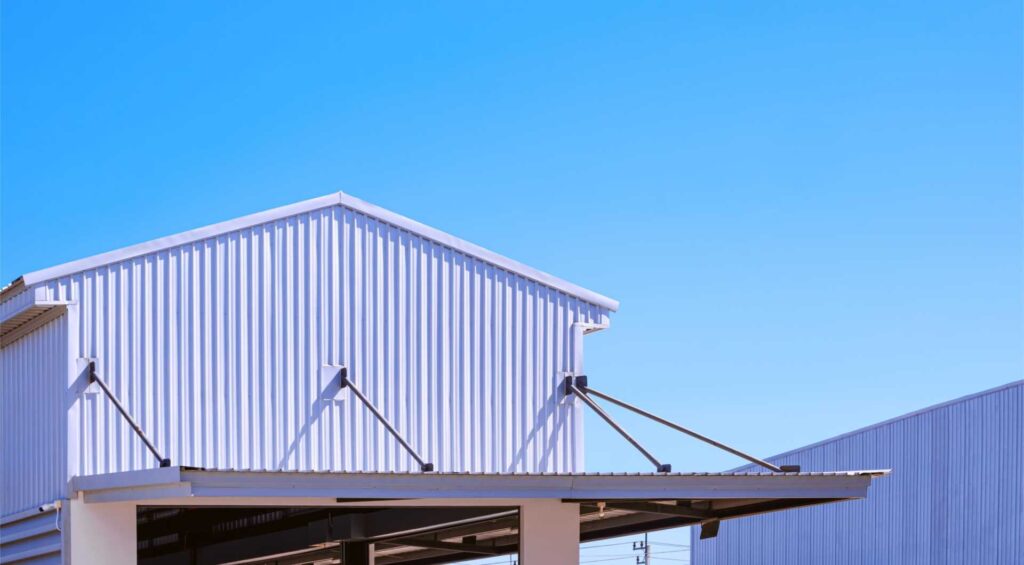
Contents
To achieve peak energy efficiency in metal building architecture, you must carefully consider every design aspect, from insulation choices to HVAC systems. The potential impact of these decisions on energy consumption is staggering. You can transform a metal structure into a beacon of sustainability by implementing creative solutions like smart lighting controls and solar panel integration. But how exactly do these components work together to create a harmonious and energy-efficient building? Let’s explore the intricate web of strategies that lead to a greener, more cost-effective future in metal building design.
Key Takeaways
- Utilize reflective roof coatings to reduce heat absorption and energy costs.
- Incorporate smart lighting controls for efficient use of electricity.
- Integrate solar panel systems for sustainable energy generation.
- Opt for energy-efficient HVAC systems for temperature regulation.
- Implement ventilation strategies for optimal indoor air quality and energy savings.
Insulation Options
Selecting the right insulation options is essential to achieving the best energy efficiency in metal building architecture. There are a variety of choices when it comes to insulation.
Two popular options are spray foam and fiberglass insulation. Spray foam insulation is known for its excellent coverage and ability to seal gaps effectively, providing a high level of insulation. On the other hand, fiberglass insulation is a more traditional choice that offers good thermal resistance and is cost-effective.
Another important insulation option to contemplate is a radiant barrier. Radiant barriers are highly effective in reflecting heat away from the building, reducing the amount of heat that enters the structure. This can greatly lower cooling costs, especially in hot climates.
Additionally, cellulose insulation is a sustainable option made from recycled paper products. It provides excellent thermal performance and is environmentally friendly.
When deciding on the best insulation options for your metal building, consider factors such as the climate in your area, your budget, and your building’s specific needs. By choosing the right insulation, you can create a comfortable and energy-efficient space that you can enjoy for years.
Roofing Materials
Your choice of roofing materials is vital to maximizing energy efficiency in metal building architecture. Consider options like reflective roof coatings to reduce heat absorption.
Insulation is another key factor in regulating indoor temperatures and reducing energy consumption.
Cool roof systems are designed to minimize the urban heat island effect by reflecting more sunlight and absorbing less heat compared to traditional roofs.
These creative roofing materials can help you create an environmentally friendly and energy-efficient building design.
Reflective Roof Coatings
Consider integrating reflective roof coatings into your metal building architecture to enhance energy efficiency and reduce heat absorption. Reflective roof coatings offer numerous benefits that can help make your metal building more enduring and cost-effective. Here are some key advantages:
Solar Reflectivity: Reflective roof coatings have high solar reflectivity properties, meaning they can reflect a significant amount of sunlight away from your building. This helps in diminishing the amount of heat absorbed by the roof, leading to lower indoor temperatures and decreased reliance on air conditioning.
Energy Savings: By reducing heat absorption, reflective roof coatings contribute to lower energy consumption for cooling purposes. This leads to noticeable energy savings over time, making your metal building more environmentally friendly and economically efficient.
Climate Control: Reflective roof coatings play an essential role inse maintaining comfortable indoor temperatures by minimizing heat transfer through the roof. This improved climate control creates a more pleasant environment for occupants while reducing the building’s carbon footprint.
Insulation Options
Integrating suitable insulation options into your metal building’s roofing materials can greatly enhance energy efficiency and sustainability. When considering insulation for your metal building, you have several options to choose from, each with its unique benefits.
Thermal barriers like foam insulation provide excellent heat resistance, helping to maintain a comfortable indoor temperature while reducing the workload on your HVAC system. Foam insulation is applied in liquid form, filling every nook and cranny to create a smooth barrier against heat transfer.
On the other hand, fiberglass insulation offers a cost-effective solution with good thermal performance. It works by trapping air pockets within its structure, slowing down heat conduction.
Radiant barriers can also be incorporated into roofing materials for enhanced efficiency. These barriers reflect radiant heat, preventing it from entering the building and keeping interior temperatures stable.
Cool Roof Systems
Exploring cool roof systems with advanced roofing materials is essential to enhancing energy efficiency and sustainability in metal building architecture. Cool roof systems offer numerous benefits that can greatly impact your building’s energy consumption and environmental footprint.
When considering roofing options, focus on materials with high solar reflectivity and thermal emittance to maximize energy savings and reduce the environmental impact of your metal building.
Solar Reflectivity: Opt for roofing materials with high solar reflectivity to bounce sunlight away from the building, reducing heat absorption and cooling costs.
Thermal Emittance: Choose materials with high thermal emittance to release absorbed heat efficiently, keeping the building cooler and decreasing the need for air conditioning.
Energy Savings: Cool roof systems can lead to substantial energy savings by reducing the demand for indoor cooling systems, resulting in lower electricity bills and a decreased carbon footprint.
Window Design
Maximize natural light intake by strategically positioning and selecting window types in metal building architecture for enhanced energy efficiency. When it comes to window design in metal buildings, proper window placement and the use of energy-efficient glass are key factors in enhancing energy efficiency while ensuring a well-lit and comfortable interior space.
Consider incorporating the following elements into your window design to enhance energy efficiency and natural light intake:
| Window Design Features | Description | Benefits |
|---|---|---|
| South-Facing Windows | Allow for optimal sunlight exposure during winter months. | Improve natural heating and light. |
| Energy-Efficient Glass | Low-E coatings and insulated glazing units to decrease heat transfer. | Reduce heat gain/loss, enhance insulation. |
| Shading Options | Exterior overhangs, shades, or blinds to manage sunlight penetration. | Reduce heat gain/loss and enhance insulation. |
| Operable Windows | Windows that can be opened for natural ventilation. | Prevent overheating and decrease glare. |
| Skylights | Bring natural light into the building’s core areas. | Decrease the need for artificial lighting during the day. |
Lighting Solutions
When considering lighting solutions for your metal building, incorporating LED fixtures can greatly improve energy efficiency.
Pairing this with daylight harvesting benefits allows you to maximize natural light usage, reducing dependence on artificial lighting during the day.
Implementing smart lighting controls further boosts efficiency by enabling precise management of lighting levels based on occupancy and natural light availability.
LED for Energy Efficiency
Enhancing metal building energy efficiency through the strategic implementation of LED lighting solutions can greatly reduce operational costs and environmental impact. By incorporating energy-saving LEDs alongside smart thermostats, metal buildings can achieve the best energy efficiency levels while contributing to an eco-friendly environment.
Here are some key points to keep in mind:
- Energy-Efficient Lighting: LED lights consume significantly lesser energy compared to traditional lighting options, leading to reduced electricity bills and lower carbon emissions.
- Longevity and Durability: LED lights have a longer lifespan and require less maintenance, making them a cost-effective lighting solution for metal buildings.
- Customizable Options: LED lighting systems offer a range of customizable choices, including dimmable settings and color temperatures, allowing for personalized lighting solutions that meet specific needs.
Utilizing LED lighting in conjunction with sustainable materials and eco-friendly design practices can transform metal buildings into energy-efficient structures that prioritize both cost savings and environmental responsibility.
Daylight Harvesting Benefits
Implementing daylight harvesting techniques in metal building architecture can greatly enhance energy efficiency and reduce reliance on artificial lighting. One effective method to maximize natural light benefits is through skylight installation. Skylights are strategically positioned on the roof to capture and distribute sunlight throughout the building, reducing the need for electric lighting during daylight hours.
By incorporating skylights into the design of metal buildings, you decrease energy consumption and also create a more inviting and productive indoor environment. Natural light has been proven to boost mood, increase productivity, and enhance overall well-being. Additionally, exposure to natural light can help regulate your circadian rhythm, leading to better sleep patterns and increased energy levels.
Through the installation of skylights, you can harness the power of natural light to illuminate your space, reduce your carbon footprint, and create an enduring building that aligns with modern energy-efficient practices.
Embracing daylight harvesting benefits the environment and enhances the quality of your indoor space. It provides a sense of connection to the outdoors while fostering a more comfortable and visually appealing atmosphere.
Smart Lighting Controls
To further enhance energy efficiency in metal building architecture and complement the benefits of daylight harvesting, integrating advanced lighting controls offers an eco-friendly and creative solution for maximizing lighting efficiency. By incorporating occupancy sensors, energy savings can be maximized as lights are activated only when spaces are in use, reducing unnecessary energy consumption.
Automated dimming features further enhance energy efficiency by adjusting light levels based on natural light availability and occupancy, minimizing power consumption throughout the day. These advanced controls contribute to sustainability efforts and also create a more comfortable and productive environment for occupants.
Embracing smart lighting solutions fosters a sense of belonging to a community committed to reducing environmental impact and adopting state-of-the-art technology for a brighter, more efficient future.
Ventilation Systems
Effective ventilation systems play a critical role in maintaining ideal indoor air quality and temperature control in metal building architecture. When considering ventilation options for your metal building, there are two main types to explore: natural ventilation and mechanical ventilation. Natural ventilation utilizes passive methods such as windows, louvers, or vents to allow fresh air to circulate, reducing the need for mechanical systems. On the other hand, mechanical ventilation involves the use of fans, exhaust systems, and HVAC units to actively control airflow within the building.
| Ventilation Type | Description | Benefits |
|---|---|---|
| Natural Ventilation | Utilizes passive methods like windows, louvers, or vents to allow natural airflow. | Energy-efficient, cost-effective, promotes a connection with the outdoors. |
| Mechanical Ventilation | Involves active systems such as fans, exhaust systems, and HVAC units to regulate airflow. | Energy-efficient, cost-effective, and promotes a connection with the outdoors. |
| Hybrid Ventilation | Combines elements of natural and mechanical ventilation for best airflow and energy savings. | It provides precise control over air quality and temperature and is suitable for larger spaces. |
When designing your metal building, a combination of natural and mechanical ventilation can offer environmentally friendly solutions that promote energy efficiency and occupant well-being. By strategically integrating these ventilation systems, you can create a comfortable and healthy indoor environment while reducing energy consumption.
Solar Panel Integration
Consider integrating solar panels into your metal building architecture to harness renewable energy and enhance energy efficiency. Solar panel integration offers numerous benefits for your building, reducing your carbon footprint and providing long-term cost savings.
Here are some key points to keep in mind:
Inverter Technology: Utilizing advanced inverter technology can improve the conversion of solar energy into usable electricity for your building. This maximizes efficiency and energy production from your solar panels.
Battery Storage: Implementing battery storage systems allows you to store excess solar energy generated during the day for use during peak times or at night. This improves your building’s energy, independence, and resilience.
Net Metering and Energy Savings: Through net metering programs, you can potentially earn credits for excess energy fed back into the grid. This not only reduces your electricity bills but also contributes to a more eco-friendly energy grid.
Energy-Efficient HVAC Systems
Enhancing the energy efficiency of your metal building architecture can be achieved through the implementation of advanced Energy-Efficient HVAC Systems.
When it comes to smart thermostats, these inventive devices offer precise control over the heating and cooling of your space. By learning your preferences and adjusting temperatures accordingly, smart thermostats improve energy usage, reducing waste and costs.
Geothermal heating is another eco-friendly option for your metal building. This system harnesses the consistent temperature below the earth’s surface to heat and cool your building efficiently. By circulating water through underground pipes, geothermal heating can significantly diminish your reliance on traditional energy sources, leading to long-term savings and a reduced environmental impact.
Summary
Maximizing energy efficiency in metal building architecture is essential for creating eco-friendly and cost-effective structures.
Metal buildings can decrease energy consumption by integrating insulation options such as spray foam or fiberglass, reflective roof coatings, efficient ventilation systems, and energy-efficient HVAC systems.
Embracing intelligent lighting controls, solar panel integration, and daylight harvesting further improves the building’s performance, supporting environmental responsibility and adaptability to evolving energy requirements.
Recent Posts
Benefits of Using Metal in Construction Projects
Isn’t it fascinating how a simple material can transform the landscape of construction? When you
What Are the Benefits of Durable Metal Construction?
While traditional building materials may offer charm, they often fall short in durability compared to
Benefits of Choosing Strong Metal for Construction
When it comes to bolstering your construction projects, opting for strong metal for construction can




